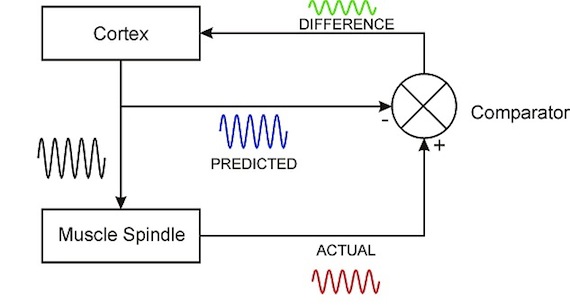The Role of Synchronous Oscillations in Sensorimotor Integration
Early EEG studies in animals and humans showed rhythmical brain activity (oscillations) at a number of different frequencies. Slow rhythms were associated with sleep whereas faster rhythms have been linked to alertness. We are interested in the oscillations that occur at a frequency of approximately 20 Hz in the motor cortex of awake humans and animals. These oscillations occur during periods of rest or sustained contraction and are related to muscle activity. We have shown that these oscillations are also present in somatosensory cortex (see figure). As yet the function of these oscillations is unknown.

The coherence between 20 Hz motor cortical oscillations the EMG of contralateral muscles is commonly assumed to be a descending phenomenon: cortical oscillations are carried by corticospinal pathways to motoneurones, and thence to muscles. We have obtained increasing evidence that oscillations traverse a feedback loop, and return to the cortex via proprioceptive afferents. We suggest that this system may act to achieve a recalibration of the motor system following a movement. By analogy with Radar or Sonar, a known test pulse is sent out; the response to this could the provide information about the state of the peripheral system (see figure). We are currently testing this hypothesis.

People involved in this project
- Dr Claire Witham (Post-doc)
- Prof Stuart Baker (Supervisor)
Publications Relevant to this Project
- Witham, C. L., Wang, M. and Baker, S.N. (2007). Cells in somatosensory areas show synchrony with beta oscillations in monkey motor cortex. European Journal of Neuroscience 26, 2677-86.
- Witham, C.L. and Baker, S.N. (2007). Network oscillations and intrinsic spiking rhythmicity do not covary in monkey sensorimotor areas. Journal of Physiology 580, 801-814.
- Riddle, C.N. and Baker, S.N. (2006). Digit displacement, not object compliance, underlies task dependent modulations in human corticomuscular coherence. Neuroimage 33, 618-627.
- Baker, S.N., Chiu, M. and Fetz, E.E. (2006). Afferent encoding of central oscillations in the monkey arm. Journal of Neurophysiology 95, 3904-3910.
- Riddle, C.N. and Baker, S.N. (2005). Manipulation of peripheral neural feedback loops alters human corticomuscular coherence. Journal of Physiology 566, 625-639.
Sponsors of this study
Back to the Projects


